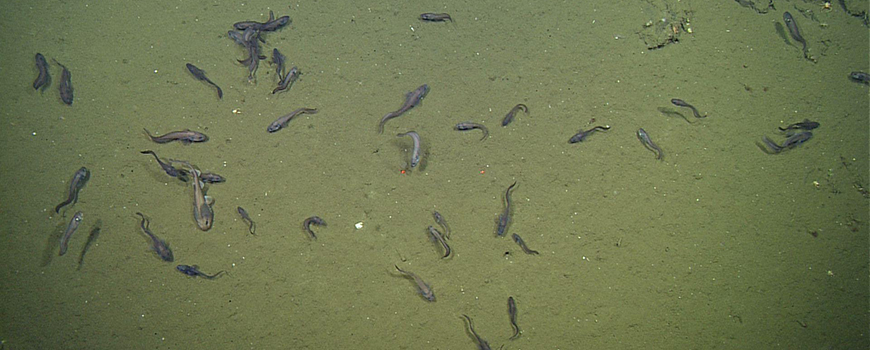Global S&T Development Trend Analysis Platform of Resources and Environment
| Research Highlight: In Waters Nearly Oxygen-Free, Researchers Find Thriving Fish Populations | |
| admin | |
| 2018-12-07 | |
| 发布年 | 2018 |
| 语种 | 英语 |
| 国家 | 美国 |
| 领域 | 资源环境 |
| 正文(英文) |  Catsharks and cusk eels on Gulf of California seafloor where oxygen levels are as little as three percent of those at surface Scientists from Scripps Institution of Oceanography at the University of California San Diego and the Monterey Bay Aquarium Research Institute (MBARI) have discovered that two species of fish are capable of living in ocean waters almost completely devoid of oxygen.
Marine biologist Natalya Gallo, a postdoctoral researcher at Scripps, and colleagues reported high abundances of fish living in deep Gulf of California waters with almost no dissolved oxygen. Two species – a catshark and a cusk eel – were described in the journal Ecology as low-oxygen extremophiles.
The study, “Home sweet suboxic home: remarkable hypoxia tolerance in two demersal fish species in the Gulf of California,” appeared in online versions of the journal Ecology Nov. 27.
Using MBARI’s remotely operated vehicle (ROV) Doc Ricketts, in March of 2015 the researchers surveyed the habitat and behaviors of fish in the Gulf of California oxygen minimum zone, a region more than 1,000 meters (3,280 feet) deep that is nearly anoxic (oxygen-free) in many places. The southern Gulf of California represents one of the most extreme low-oxygen environments in the world’s oceans, with extensive suboxic regions, containing less than three percent of the oxygen concentration typically found at the ocean’s surface. These extreme low-oxygen areas are inhospitable for most animals.
“I distinctly remember the moment when we went over a ledge with the ROV and saw hundreds of these cusk eels, along with several other species of fish, swimming around,” Gallo said. “I could hardly believe my eyes. We were in a suboxic habitat, which should exclude fish, but instead there were hundreds of fish. I immediately knew this was something special that challenged our existing understanding of the limits of hypoxia tolerance.”
These new observations suggest that the catshark, Cephalurus cephalus, and the cusk eel, Cherublemma emmelas, seem to prefer this seemingly inhospitable environment, and were at times observed swimming over areas resembling bare moonscapes; they were absent from better-oxygenated areas. It is still unclear what physiological adaptations allow these two species to live under such low-oxygen conditions, but both species have relatively small body sizes and large gill surfaces, and likely use a combination of strategies for reducing oxygen demand and increasing oxygen uptake capacity.
The authors propose the term “ligooxyphile” to refer to animals that can exist in low-oxygen environments and suggest that these fish represent the most hypoxia-tolerant fish species ever described. Understanding the tolerance ranges of species to hypoxia takes on new relevance as the world’s low oxygen zones expand with climate change. These low-oxygen extremophiles may be climate change winners in the future, with a potential to expand their ranges, the authors said.
“However, continued warming of the ocean may challenge even the most hypoxia-tolerant fishes,” said co-author Lisa Levin, a biological oceanographer at Scripps. “Elevated temperature will lower the solubility of oxygen in the water while increasing the amount of oxygen the fish need to survive. I hope these sites can be revisited sometime in the future to see how the fish have fared.”
The David and Lucile Packard Foundation provided primary support for the research. Additional support came from the Switzer Environmental Leadership Fellowship and the National Science Foundation (NSF) Graduate Research Fellowship Program.
Co-authors of the study include Maryanne Beckwith of Scripps and Jim Barry of MBARI. Gallo’s portion of the research was supported by the NSF under grant DCE-1144086.
– Robert Monroe
This story appears in explorations now, Scripps Institution of Oceanography's award-winning ocean and earth science magazine. Sign up to receive our free monthly story roundup.
|
| URL | 查看原文 |
| 来源平台 | Scripps Institution of Oceanography |
| 文献类型 | 新闻 |
| 条目标识符 | http://119.78.100.173/C666/handle/2XK7JSWQ/107737 |
| 专题 | 资源环境科学 |
| 推荐引用方式 GB/T 7714 | admin. Research Highlight: In Waters Nearly Oxygen-Free, Researchers Find Thriving Fish Populations. 2018. |
| 条目包含的文件 | 条目无相关文件。 | |||||
| 个性服务 |
| 推荐该条目 |
| 保存到收藏夹 |
| 查看访问统计 |
| 导出为Endnote文件 |
| 谷歌学术 |
| 谷歌学术中相似的文章 |
| [admin]的文章 |
| 百度学术 |
| 百度学术中相似的文章 |
| [admin]的文章 |
| 必应学术 |
| 必应学术中相似的文章 |
| [admin]的文章 |
| 相关权益政策 |
| 暂无数据 |
| 收藏/分享 |
除非特别说明,本系统中所有内容都受版权保护,并保留所有权利。
修改评论